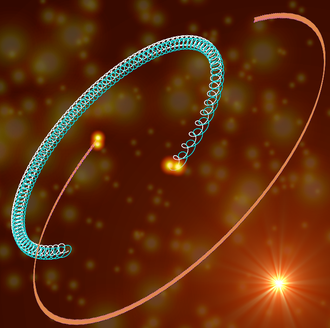
An international team of astronomers, including Rodolfo Smiljanic from the Nicolaus Copernicus Astronomical Center in Warsaw, have identified a stellar quadruple system (HD 74438) that seems to be evolving to become a supernova of type Ia. This type of supernovae are thought to happen from the thermonuclear explosion of a white dwarf in a binary system. However, there are still many uncertainties regarding type Ia supernovae.
The nature of the progenitor system (whether it is made of two white dwarfs or a white dwarf plus a giant star) and the exact details of how the explosion ignites are still debated. Nevertheless, these supernovae are very important in astrophysics as they are used as standard candles for fixing the Universe distance scale. In addition, type Ia supernovae are important producers of chemical elements around iron in the periodic table.
Star HD 74438 was discovered to be a spectroscopic quadruple system in 2017 using data from the Gaia-ESO Survey. Subsequent follow-up spectroscopic observations of HD 74438 were obtained with high-resolution spectrographs at University of Canterbury Mount John Observatory in New Zealand and at the Southern African Large Telescope in South Africa. These observations allowed the team to determine that the system has four gravitationally-bound stars in a 2+2 configuration. One binary with a short period of 4 days orbiting another binary with a short period of 21 days. HD 74438 is member of the open cluster IC 2391, making it the youngest (43 million of years) spectroscopic quadruple discovered so far. It is also among the quadruple systems with the shortest outer orbital period (the two binary systems orbit each other with a period of 6 years).
The analysis showed that this quadruple system is undergoing dynamical effects on long time scales compared to the orbital periods. Indeed, one of the inner binaries should have already evolved into a circular orbit but it still has an eccentric one. This is explained by the gravitational effect of the distant binary companion which can pump up the eccentricity of the other system. State-of-the art simulations of the future evolution of HD 74438 show that such gravitational dynamics can lead to one or multiple collisions and merger events producing white dwarfs with masses just below the Chandrasekhar limit (of 1.44 solar masses). If the mass crosses this limit, as a result of mass transfer or of a merger event, the system can produce a type Ia supernova. Interestingly, 70 to 85% of all supernovae type Ia are now suspected to result from the explosion of white dwarfs which initially had sub-Chandrasekhar masses. The evolution of stellar quadruples such as HD 74438 thus represents a new promising channel to form this type of supernovae.
The study of HD 74438 is described in:
T. Merle, A. S. Hamers, S. Van Eck, A. Jorissen, M. Van der Swaelmen, K. Pollard, R. Smiljanic, D. Pourbaix, T. Zwitter, G. Traven, G. Gilmore, S. Randich, A. Gonneau, A. Hourihane , G. Sacco and C. C. Worley
"A spectroscopic quadruple as a possible progenitor of sub-Chandrasekhar type Ia supernovae", Nature Astronomy
Text by: T. Merle (ULB, Belgium) and R. Smiljanic (CAMK)
Figure caption: "Trajectories within the quadruple stellar system HD 74438: the two close pairs, having orbital periods of 21 and 4 days, orbit around each other in 6 years. At some point, the two pairs could merge into white dwarfs giving rise to a thermonuclear supernova, as illustrated in the bottom right."






